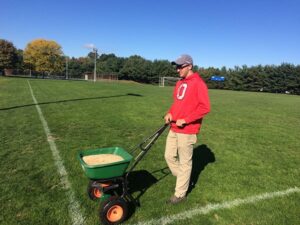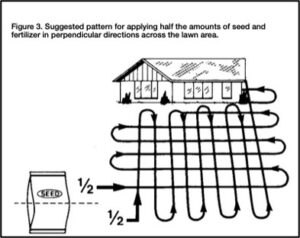Time to Fertilize Those Lawns
go.ncsu.edu/readext?935628
en Español / em Português
El inglés es el idioma de control de esta página. En la medida en que haya algún conflicto entre la traducción al inglés y la traducción, el inglés prevalece.
Al hacer clic en el enlace de traducción se activa un servicio de traducción gratuito para convertir la página al español. Al igual que con cualquier traducción por Internet, la conversión no es sensible al contexto y puede que no traduzca el texto en su significado original. NC State Extension no garantiza la exactitud del texto traducido. Por favor, tenga en cuenta que algunas aplicaciones y/o servicios pueden no funcionar como se espera cuando se traducen.
Português
Inglês é o idioma de controle desta página. Na medida que haja algum conflito entre o texto original em Inglês e a tradução, o Inglês prevalece.
Ao clicar no link de tradução, um serviço gratuito de tradução será ativado para converter a página para o Português. Como em qualquer tradução pela internet, a conversão não é sensivel ao contexto e pode não ocorrer a tradução para o significado orginal. O serviço de Extensão da Carolina do Norte (NC State Extension) não garante a exatidão do texto traduzido. Por favor, observe que algumas funções ou serviços podem não funcionar como esperado após a tradução.
English
English is the controlling language of this page. To the extent there is any conflict between the English text and the translation, English controls.
Clicking on the translation link activates a free translation service to convert the page to Spanish. As with any Internet translation, the conversion is not context-sensitive and may not translate the text to its original meaning. NC State Extension does not guarantee the accuracy of the translated text. Please note that some applications and/or services may not function as expected when translated.
Collapse ▲Now that your grass is green and you have had a couple of mowing opportunities, it is time to think about providing your turfgrass with fertilizer. Over the past several weeks I have observed several lawns that would greatly benefit from a nutrient boost. This included lawns with sandy soils, nematode issues, and poorly drained areas that have left many lawns searching for nutrients needed to develop strong roots and lush, green growth.
When fertilizing lawns, the best place to start is with a soil test. A soil test will provide you with a current snap shot of your soil fertility and what will be needed for the next 2-3 years to maintain proper pH levels. Soil pH is a critical factor in plant growth and can only be determined through soil testing. Soil testing materials are available through your local Extension office, and can be submitted to the North Carolina Department of Agriculture Soil Testing Lab. For more information on the soil lab and its services, review their soil testing brochure.
Armed with this information, you can make adjustments to soil pH and three critical soil nutrients (Nitrogen, Phosphorus, Potassium). To simplify this process, here a few keys points to remember:
- The four most common lawn grasses grown in Pamlico County are centipedegrass, bermudagrass, zoysiagrass, & St. Augustine. Information for each turfgrass variety can be found at the NC State Extension Turffiles website.
- Centipedegrass grows best with a soil pH value near 5.5.
- All other common turfgrasses recommended for Pamlico County grow best with a soil pH of 6-6.5.
- Lime is used to raise soil pH; elemental sulfur is used to lower soil pH.
- A soil test will report phosphorus and potassium values with an index. Index values above 50 means your soil will not respond to additional fertilizer containing these elements (you do not need it).
- Soil tests do not measure nitrogen levels. Nitrogen recommendations are based upon known growth response from nitrogen fertilizer.
- All fertilizer sources eventually end up in the same forms before plants can use them (i.e., plants do not care if your fertilizer is organic, natural, synthetic, slow release, only that there is enough).
Once you have conducted a soil test, you can adjust your phosphorus and potassium levels based upon the resulting recommendations. You will generally only need to conduct a soil test every 2-3 years to ensure your pH and phosphorus values are in the proper range. Since phosphorus does not leach from soil, a single application will probably last you several growing seasons. This is important, because excessive soil phosphorus levels can be detrimental to the growth of centipedegrass and will add cost you do not need. Lime may also be required to raise soil pH to optimal levels; however, never add lime unless a soil test explicitly shows a need. Overliming is a difficult condition to correct and will take several years to remedy.
Finally, most turfgrasses will require multiple applications of nitrogen fertilizer to look their best. Again, do not overthink this process. Follow the recommended nitrogen fertilizer schedule from table 3C in the “Carolina Lawns” publication from NC State Extension, and you should have few issues. When purchasing nitrogen fertilizer do some cost comparison among products and blends. There are several sources of nitrogen fertilizer, each with its own cost. Generally speaking, products containing higher amounts of nitrogen are more economical. Application of fertilizer can easily be accomplished with a hand-held rotary spreader or push spreader. For more information on how to calibrate a spreader for proper application, visit the Pesticide Environmental Stewardship website. The information presented here provides both a video and written instructions for setting up a rotary spreader. This information is applicable to any product that can applied with these spreaders (insecticides, fungicides, herbicides, fertilizer).
If you would like more information on fertilizer and maintaining your lawn, please contact Daniel Simpson at 252-745-4121 or daniel_simpson@ncsu.edu.





